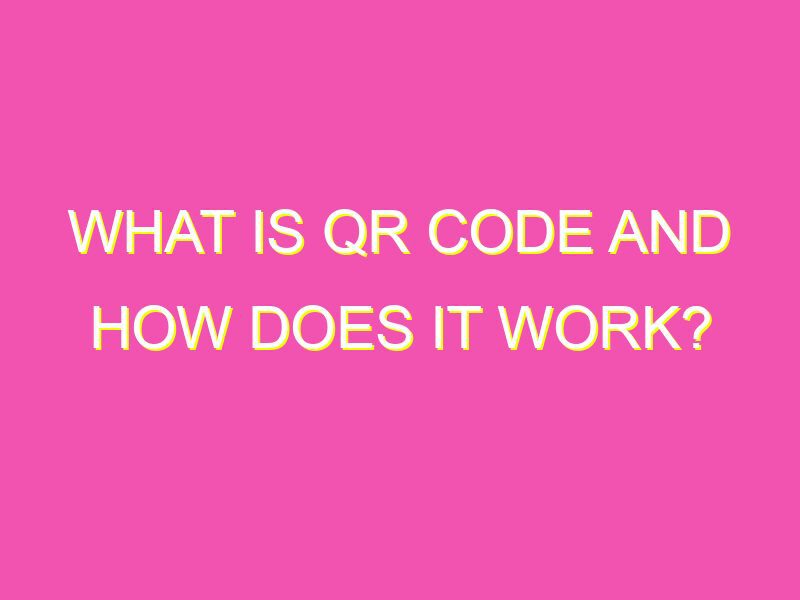QR codes, also known as quick response codes, are a super cool type of two-dimensional barcode that can be scanned by smartphones and other mobile devices. They allow for the storage of information like website URLs, text, and contact details in a specific black and white pattern. Convenient and versatile, QR codes have become increasingly popular in recent years.
Businesses and individuals alike can benefit from using QR codes to simplify and streamline their operations. So whether you’re a marketer, a retailer, or just looking to digitize your payment system, QR codes are the way to go.
Introduction: What is a QR code?
QR code or Quick Response code is a two-dimensional barcode that can be read by a smartphone camera. It was first invented in 1994 by Denso Wave, a subsidiary of Toyota, to track vehicles during the manufacturing process. QR codes are capable of storing large amounts of data, such as URLs, contact information, product information, and more. One of the benefits of using QR codes is that it allows information to be quickly and easily accessed by consumers.
The History of QR Codes
QR codes were first used in the automotive industry to track vehicles during the manufacturing process. However, it wasn’t until the rise of smartphones that QR codes became more widely used. In 2011, QR codes were integrated into the Apple iOS operating system, which allowed users to scan QR codes without the need for a third-party app. Since then, QR codes have become increasingly popular in advertising and marketing.
How Do QR Codes Work?
QR codes work by encoding data in a two-dimensional barcode that can be read by a smartphone camera. The data is stored in a series of black and white pixels that are arranged in a grid. When a smartphone camera scans the QR code, the data is decoded and displayed on the screen. QR codes can be used to store a variety of data types, including plain text, URLs, contact information, product information, and more.
The Benefits of QR Codes
QR codes offer a number of benefits for both businesses and consumers. These benefits include:
- Convenient: QR codes allow consumers to quickly and easily access information by simply scanning the code with their smartphone camera.
- Cost-effective: QR codes are easy and inexpensive to create, making them a cost-effective marketing tool for businesses.
- Trackable: QR codes can be used to track consumer behavior, such as how many people scan the code and when they do so.
- Engaging: QR codes can be used to engage consumers in a variety of ways, such as by providing exclusive content or offering discounts.
QR Codes in Advertising and Marketing
QR codes have become increasingly popular in advertising and marketing. Businesses can use QR codes to provide consumers with information about their products and services, as well as to offer incentives such as discounts or exclusive content. QR codes can be printed on a variety of marketing materials, including posters, flyers, business cards, and product packaging. Some examples of how QR codes are being used in advertising and marketing include:
- Providing product information: QR codes can be used to provide consumers with detailed product information, such as ingredients, nutritional information, and usage instructions.
- Offering discounts: QR codes can be used to provide consumers with discounts on products or services.
- Providing exclusive content: QR codes can be used to provide consumers with exclusive content, such as behind-the-scenes footage, interviews, or special offers.
- Entering sweepstakes: QR codes can be used to enter sweepstakes or contests, providing businesses with valuable consumer information.
How to Create Your Own QR Code
Creating your own QR code is easy and can be done in just a few steps. Follow these steps to create your own QR code:
- Choose a QR code generator: There are a variety of QR code generators available online, such as QR Code Generator and QRStuff.
- Select the type of data you want to store: Choose the type of data you want to store, such as a URL or contact information.
- Enter the data: Enter the data you want to store into the QR code generator.
- Customize the QR code: Customizing the QR code to suit your branding, such as by adding a logo or adjusting the color scheme, can help increase brand awareness.
- Download the QR code: Once you have created your QR code, download it and use it in your marketing materials.
Potential Downsides of QR Codes
While QR codes offer many benefits, there are also potential downsides to using them. These downsides include:
- Low adoption rate: While QR codes are becoming more popular, there is still a relatively low adoption rate among consumers. If consumers are not familiar with QR codes or do not have a smartphone capable of scanning them, they are unlikely to use them.
- Security risks: QR codes can be used to deliver malware or direct users to fraudulent websites. Consumers should be cautious when scanning QR codes from unknown sources.
- Accessibility issues: QR codes may be difficult or impossible for visually impaired users to access, as they require the use of a smartphone camera.
Conclusion: The Future of QR Codes
Despite the potential downsides, QR codes are likely to continue to be an important marketing tool in the future. As smartphones become more prevalent and consumers become more familiar with QR codes, businesses will continue to find innovative ways to use them in advertising and marketing. However, it is important for businesses to be aware of the potential downsides and take steps to mitigate any risks. By using QR codes in a responsible and thoughtful way, businesses can enjoy the many benefits they offer while minimizing any potential downsides.





